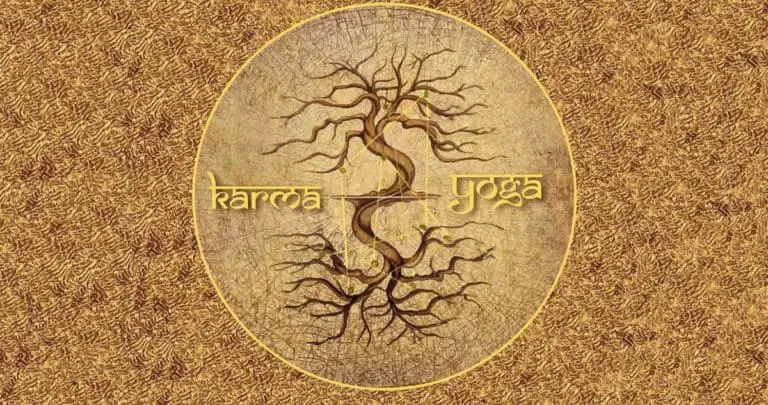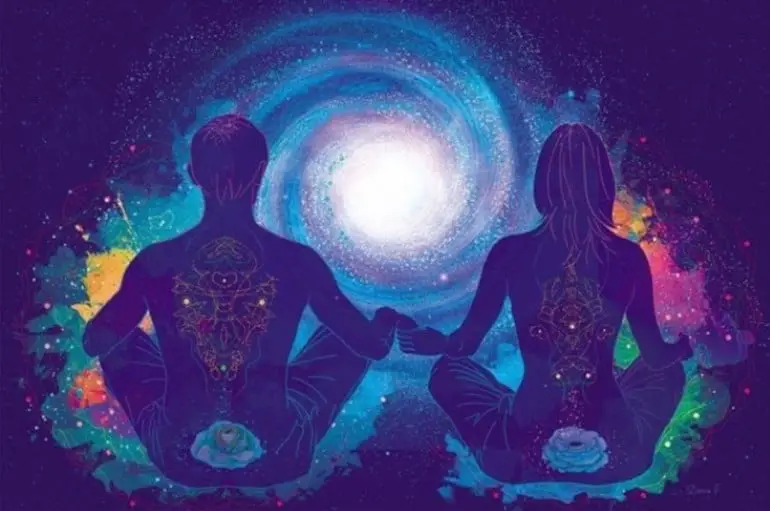The Basis and Essence of Karma Yoga This article is devoted to the general concept of the theory of the law of karma, which will tell where the concept of karma itself came from, and how it is interpreted in various spiritual schools and religious teachings.
Some people think that the origin of this law is connected with Vedism, others attribute it to Buddhism, and others generally to new trends formed in modern spiritual practices. Both are partly right, but in order to find out where the law of karma really came from, we must turn deep into the eyelid.
Liberation Theory and Karma
The basis and essence of Karma yoga is an action or deed. Karma is an event that has a specific purpose. If a carpenter makes a chair, then they talk about his specific actions, and if the banner is developing in the wind, then this is not considered an action, in this case, they say that the banner is just moving. This is the difference between movement and action. There is a concept of the law of karma when people receive encouragement or punishment for their bad or good deeds.
This type of yoga is called the yoga of activity, because it teaches the right way of life, how to treat others, and what actions to perform in a particular life situation. Karma yoga explains how you can become a yogi without going to a special school. It is an application to all other types of yoga because with its help people never forget about their goal and strive for it.
The theory of liberation and karma what is it?

This direction means absolutely any activity that does not have the goal of achieving personal results. This activity does not necessarily have to be useful and good. If it is aimed at changing something in yourself or in the people around you, then this is not karma yoga. Work done for a specific purpose is an action dictated by the law of karma. Therefore, it is impossible to completely get rid of it. People who perceive karma yoga as a “service” are considered not yogis, but servants, whose consciousness ossifies over time. The accumulation of rewards for performing good deeds will still not lead to absolute liberation, as stated in the Vedas.
Karma yoga does not lend itself to the logic accepted in society. Its followers do not make attempts to save the world when they know that there is no need for it. If they help someone, or, on the contrary, interfere, then they do it without specific goals and intentions. Therefore, yogis cause less harm than those people who try to teach others the right life. For those who have experience in this direction, life is transformed into karma yoga, because they perform most of their actions without intentions.
The basic principles of Karma yoga
The basis of karma yoga is non-attachment. People who practice this type of yoga should not be inclined to something bad or good, to pleasure or suffering. This does not mean that a person is completely indifferent to everything. They just have a detached attitude to everything that is happening or to their own activities. He has no desire to isolate himself from the whole world, he is aware of the fact that everything happens according to certain laws and that everything has its own destiny.
Karma Yoga Practice

In the Bhagavad Gita, three main principles of karma yoga are highlighted:
- To do the work for the sake of the action itself, and not for the sake of the result. Be indifferent to success and failure.
- Work with maximum productivity but without excessive fanaticism.
- Do not be tied to the results of your activities. When the work is done, leave it with the understanding that the result depends on the Almighty.
These are the classical principles in karma yoga classes. If you follow them for a long enough time, you can gradually open up new unexplored zones in your own consciousness. All spiritual ascetics dream of getting rid of the karma acquired earlier.
Paramahamsa Satyananda believed that it was necessary to get rid of thorns with thorns. How to achieve this? He was sure that if he selflessly served others, then his selfish karma would decrease. Freeing himself from attachments over time, the sadhaka rises to a new point of spiritual development.
The highest point in karma yoga is considered when a person supports a certain lifestyle in which he helps other people to grow, develop, improve, and make them cheerful. It does not have to be material things, such as money, food, clothing, but also spiritual things – ideas, thoughts, beliefs.
If a person observes this rule for a long enough time and forms an indifferent attitude to the results of his activities, then the tangle of his karma will quickly unravel, making him freer and happier. During karma yoga classes, many of its supporters fall into a common trap. To overcome it, you need to learn to feel the world around you and act only when it is really necessary. The main thing is to always remember these nuances, then the practice will become as effective as possible.
12 laws of karma

The laws of karma are unchangeable
It is important to note the following aspect of the concept of karma: it is not a punishment or retribution, although it can be translated this way. Karma is the consequences that a person receives based on how he lives. There is no influence of providence here, so a person decides what will be best for him, and he can decide for himself how to behave in order to influence fate as much as possible in this and subsequent incarnations.
12 laws of karma that will change your life
- The first law is the great one. The law of cause and effect. What you sow, you will reap.
- The second law is the law of creation. Life began a long time ago, but it requires us to participate. We are part of it. From this, we can conclude that the accumulated karma of the members of society also affects the development of the whole society.
- The third is the law of humility. Acceptance of the situation. This is one of the most popular laws, which is currently simply exploited for no reason and for no reason by various spiritual teachers. Its essence is that only by accepting the situation, a person will be able to change it. In general, it says even more than about the acceptance itself: rather, it is about awareness. As soon as you become aware of the situation or the state in which you are, you will be able to influence it.
- The third is the law of humility. Acceptance of the situation. This is one of the most popular laws, which is currently simply exploited for no reason and for no reason by various spiritual teachers. Its essence is that only by accepting the situation, a person will be able to change it. In general, it says even more than about the acceptance itself: rather, it is about awareness. As soon as you become aware of the situation or the state in which you are, you will be able to influence it.
- The fourth is the law of development. An individual should change something as a matter of first importance in himself. By changing himself from within, he completely changes himself from an external perspective, accordingly influencing the climate.
- The fifth is the law of responsibility. What happens to a person in his life depends on his actions in past and present lives.
- The sixth law is about communication. Everything we do in the present or in the past has an impact on the environment and the future. Here it will be appropriate to recall the butterfly effect. Any seemingly insignificant action or thought has an impact on us and on others.
- The seventh is the law of focus. You can’t think about two things at the same time.
- The eighth is the law of thanksgiving. Here we are not talking about gratitude to someone in particular, or even about gratitude to the deity, but to the world as a whole. What you have learned, you will have to apply it one day. This will be your gratitude towards the universe.
- The ninth law is here and now. Again, this is one of the most popular laws borrowed by many spiritual schools. The concentration of thought on the present moment, because being in the present, but thinking about the past or the future, we miss the present moment, depriving it of its primordial nature. It flies in front of us, but we do not notice it.
- The tenth is the law on change. The situation will not change and will be repeated in different forms until you learn the right lesson from it.
- The eleventh is the law of patience and reward. In order to get what you want, you need to apply diligence, and then the desired reward will become available. But the greatest reward is the joy that a person receives from performing the right actions.
- The twelfth is the law of meaning and inspiration. What you have invested a lot of energy in plays a great role in your life, and vice versa.
There are likewise purported 9 laws of karma, yet they for the most part copy the all-around existing 12 and identify with the further development of the hypothesis of the law of karma. To put it plainly, the law of karma can be summed up as follows: all that happens to an individual in life is the aftereffect of his activities before or present and is pointed toward reestablishing the harmony between what is done and what is being done in the present and what’s to come.
Buddhi Yoga

Buddhi yoga teaches not to think about the spirit, as well as about filling the real shell. Buddhi yoga says that the spirit is a particle of the Universe, a molecule of the Creator, and an energy ray that should be filled with positive energy and its correct direction for the benefit of the World. There are several stages of information about the education of Buddhi yoga:
- The exit of the spirit (cognizance) past the actual shell and its dispersion into two equivalent parts – the lower one, which is liable for the association with the body, and the upper one, which is near the Universe;
- The improvement of the lower segment pointed toward acknowledging oneself as a piece of the world. The proficient embodies himself with a little stuff of the system, which can’t impact the general arrangement, however, can set everything in motion.
- The development of the upper head component is achieved through prolonged meditation. At this stage, a person is able to achieve Nirvana and learns to see himself from the outside;
- The next stage of the development of consciousness is going beyond the limits of our world and our Universe and its aspiration to the Creator;
- The final highest stage of progress is the aspiration to God and his Abode.
At any of these stages, a person denies himself as a being endowed with the right to choose and loses the illusion of self-control over his life and fate. The soul gives itself to the will of the Lord, allowing him to influence the course of life, thereby rushing to the sources of Existence.
The main principles of karma yoga

The basics of karma yoga are based on the following points:
The right attitude to life
What matters is not what you do, but with what attitude you perform it. Thus, it turns out that actions are a binding or liberating factor for you
It is better to do what you like, and not what you have to do.
The right rationale. The genuine inspiration of what you are doing is significant. Activities ought to be performed for the actual activities, and not for their organic products.
Satisfying an obligation. “Obligation” is seen as equity. In the event that you continually overlook its execution, you can acquire an awful standing. The obligation is essentially a mentality to God or the internal identity, which trains you to act somehow in various life situations. Do you know? In the Bhagavad Gita, Krishna calls attention to Arjun the accompanying standards: “Accomplish the fundamental work, it is superior to sitting idle; If you don’t do anything, you won’t satisfy even the elements of the body.” Additionally: “Thus, consistently make the best decision without connection; Whoever takes up the errand without connection achieves the Highest.”
Do all that relies upon you. Assuming you realize the most ideal approach to tackle the issue, don’t stop for a second to pick it. You ought not to withdraw from taking care of issues in view of dread of analysis or reluctance to strain yourself. Attempt to make every one of the activities bring however much good as could reasonably be expected.
Dismissal of the outcome. Just God is the practitioner, and you are just an instrument in the possession of higher powers. There is no awful or great work, so you ought not to get joined to it. On the off chance that vital, it will be important to leave behind it. It is important to work for the actual activity, and not for the outcome. Simultaneously, be quiet about both achievement and disappointment in business.
Serve God and the higher self in all things. Try not to be sluggish to help other people and do how you might want to help yourself. Try not to squabble, be mindful and supportive, and adjust. Any affront to another person is hurt, undoubtedly, to yourself. Try not to pursue power, and greatness, be careful with commendatory tributes.
Meet the fundamental prerequisites. Any work shows something, including growing new one’s skills.
Spiritual exercises

It will be valuable for you to find out about how to begin rehearsing yoga at home, just as what asanas are in yoga and what their job is.
Regardless, you should dominate three fundamental activities:
Smoothly see the positive consequences of their exercises, yet additionally adverse ones
Your inward world ought to get impervious to the rest of the world.
Work proficiently, however, don’t show inordinate fixation.
While getting the outcomes, don’t concentrate on them. The primary concern is simply the activities.
The state when performing activities is basically the same as youngsters’ games. Here’s a child tower out of 3D squares or made a cake in the sandbox. As far as he might be concerned, the main thing is the way toward making them. Then, at that point, he can annihilate them without lament and take up another business that additionally excites interest and adds to its turn of events.
Any interaction or activity can turn into contemplation and a profound exercise in karma yoga — work, family obligations, interests, or instructive games with a youngster.
On the off chance that you generally keep these straightforward standards, you can accomplish internal harmony and something else, open new degrees of cognizance. It won’t be so natural without understanding the standards of karma yoga.
Do you know? Kid clinicians accept that the best inspiration for contemplating is intellectual, and not staying away from disappointments (deuces and guardians ‘ dismay), renown (the inclination that you are the awesome) achievement (fulfillment from what you have accomplished). This methodology, when a kid feels glad about learning new things, from dominating certain abilities without reference to the outcomes, is karma yoga.





















